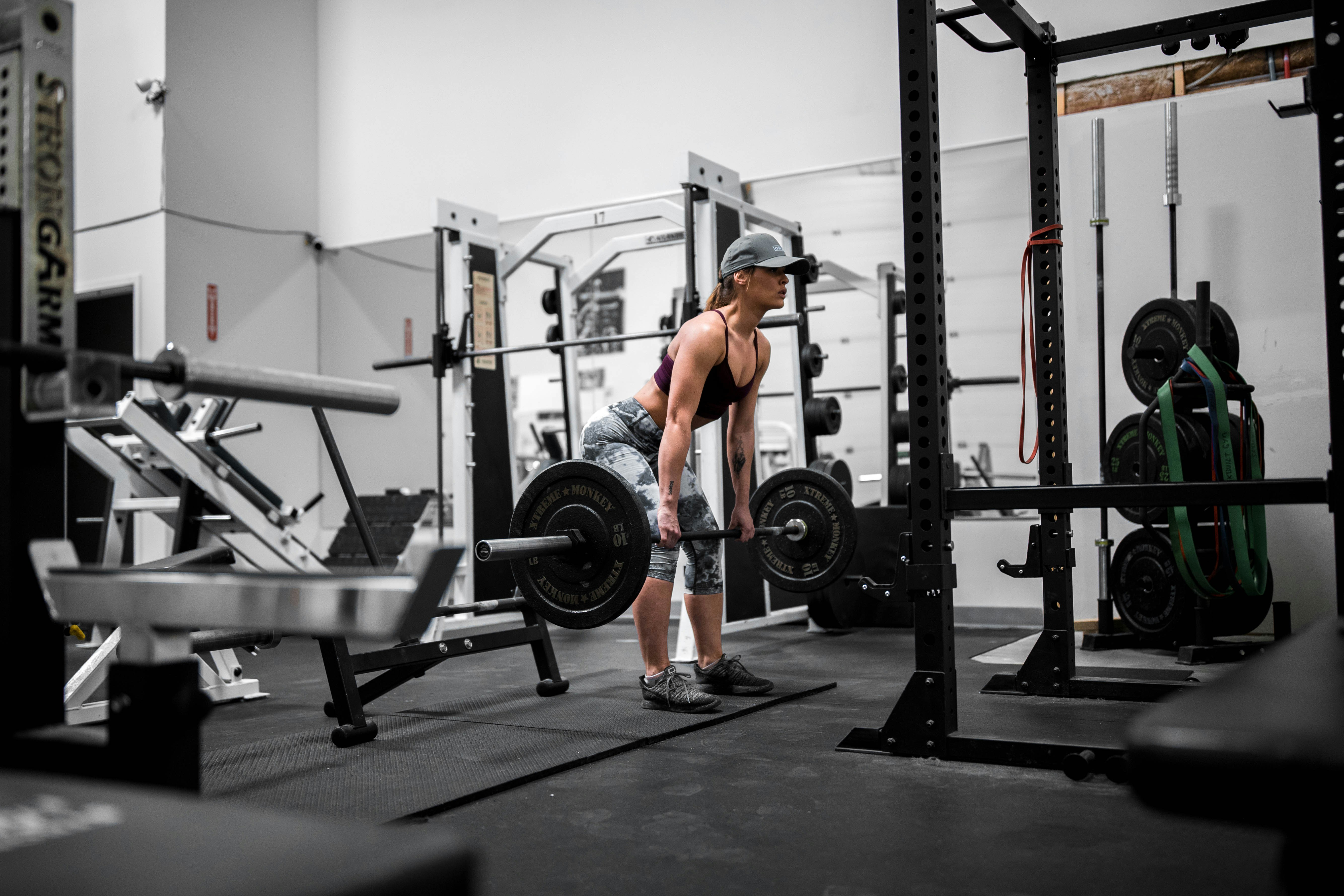
Photo by Ambitious Studio* | Rick Barrett on Unsplash
The T Bar Row and the Barbell Row are both essential exercises for building a strong back. Both are horizontal pulling movements that target multiple muscle groups, including the upper back, lats, traps, and even the biceps and forearms. However, they have distinct differences in execution and muscle engagement.
The T Bar Row involves a barbell anchored at one end while you lift the other end with a V-handle or close grip. This setup provides more stability and often allows lifters to use heavier weights. The fixed path of the bar in the T Bar Row means your core and lower back are less taxed, making it easier to focus solely on upper back development. According to a study published in the Journal of Strength and Conditioning Research, the T Bar Row places less strain on the lower back due to its more stable structure and shorter range of motion (Fenwick et al., 2009)[source].
On the other hand, the Barbell Row requires more core engagement and lower back stability. You perform this exercise by bending over at the hips with knees slightly bent and lifting a loaded barbell from the floor to your torso. This involves a greater degree of muscle activation in the lower back and hamstrings, making it a more complex and challenging movement. This also means it’s effective as a compound exercise for building overall posterior chain strength.
Both exercises have their place depending on individual goals and preferences. The T Bar Row may be better suited for those looking to build upper back strength without putting too much strain on the lower back. In contrast, the Barbell Row could be more beneficial for lifters focusing on building overall lower and upper back strength.
For more details on other muscle-building exercises that incorporate back workouts, consider checking out our article on Back Exercises with Barbell.
Key Differences Between T Bar Row and Barbell Row
When comparing the T Bar Row and Barbell Row, several key differences stand out that can influence your choice based on your training goals, experience level, and physical conditions.
Range of Motion and Bar Path
One significant difference is the range of motion and bar path. The T Bar Row allows for typically lifting more weight due to its landmine setup, which reduces the range of motion. This setup, combined with a lower torso position and more knee bend, generally offers a shorter, more controlled bar path (BarBend). On the other hand, the Barbell Row demands a stiffer hip hinge position with less knee bend, increasing the range of motion and necessitating more lower back and hamstring activation.
Muscle Engagement
The muscle groups activated during each exercise show distinct variations. The fixed bar path and neutral grip of the T Bar Row focus more on the upper back while reducing the core and postural stability demands. This results in better engagement of the rhomboids and traps, contributing to a thicker back. The Barbell Row, with its wider grip, emphasizes the lats more and requires significant core stabilization and lower back engagement.
Setup Complexity
Setting up for these exercises also diverges. The T Bar Row requires a landmine attachment or wedging the barbell into a corner, along with a V-handle or towel for a neutral grip. Conversely, the Barbell Row simply needs a barbell and weights, making it easier to set up but demanding better hip hinge proficiency.
Load and Stability
Due to its stability, the T Bar Row typically allows for heavier lifting. The neutral grip is stronger, and the supported position reduces lower back strain. However, the Barbell Row involves more spinal stiffness and compressive forces on the spine, making it a more comprehensive exercise for strengthening the posterior chain, including the lower and upper back.
Each of these exercises has unique advantages depending on your specific fitness goals. For a more detailed comparison of similar exercises, you might find our analysis on Pendlay Row vs Barbell Row insightful.
Muscles Worked: T Bar Row vs Barbell Row
When comparing the muscles worked by T Bar Rows and Barbell Rows, it’s important to note that both exercises primarily target the muscles of the back, but they do so in slightly different ways.
T Bar Row: The T Bar Row is known to engage the upper back muscles more intensely due to the positioning and range of motion involved. The fixed bar path provided by the landmine attachment reduces the demand on the core and puts more focus on the upper back muscles, including the trapezius, rhomboids, and rear deltoids. Additionally, the neutral grip used in T Bar Rows allows for greater weight to be lifted, which contributes to building a thicker upper back. This exercise also slightly involves the latissimus dorsi, but to a lesser extent compared to the barbell row.
Barbell Row: On the other hand, the Barbell Row targets both the upper and lower back more evenly. The wider grip and free bar path put more emphasis on the latissimus dorsi, which is crucial for developing a V-tapered back. The barbell row requires more core stability and greater engagement of the hamstrings to maintain the hip hinge position. This positioning activates the lower back muscles more significantly, making it a comprehensive exercise for the entire back.
Both these exercises are effective for developing back strength and muscle mass, but the choice between the two can depend on individual goals. For those aiming for upper back hypertrophy, the T Bar Row might be more suitable. In contrast, the Barbell Row offers a balanced development of both upper and lower back musculature, making it a versatile addition to any strength training program.
For further insights into back exercises, you might find our article on Pendlay Row vs Barbell Row interesting.
References:
- Fenwick, C. M. J., Brown, S. H. M., & McGill, S. M. (2009). Comparison of Different Rowing Exercises: Trunk Muscle Activation and Lumbar Spine Motion, Load, and Stiffness. Journal of Strength and Conditioning Research, 23(2), 350–358.
- BarBend
Advantages of T Bar Row

Photo by Samuel Girven on Unsplash
The T Bar Row is a favored exercise among fitness buffs for several reasons. Firstly, it effectively builds both mass and strength in the back muscles. This exercise allows for substantial weight loading, which can help in increasing back strength and muscle size. What’s more, the T Bar Row accommodates various grips such as overhand, underhand, wide, and neutral. Each grip targets different muscle groups, enhancing the versatility of the workout.
One of the significant benefits is the ease of loading and unloading weights. Unlike many free-weight exercises where loading plates can be cumbersome, the T Bar Row setup allows for a more straightforward switch of weights. This can save time and energy, especially during high-intensity workouts.
Moreover, the T Bar Row is relatively safer to execute when compared to the Barbell Row. The fixed rod pivot adds stability, aiding in maintaining proper form and reducing the risk of injury, particularly for the lower back. This stability ensures that even when lifting heavy, you can concentrate on working your muscles efficiently.
Lastly, the T Bar Row’s ability to utilize different grips within the same session offers a unique advantage. By switching grips mid-set, you can effectively fatigue the muscles and achieve a more comprehensive workout. For example, transitioning from an overhand to an underhand grip can allow you to continue lifting even as muscles start to tire.
You can find more information on related back exercises, visit our At-Home Dumbbell Back Workout page.
For further reading, you can check out Set for Set’s detailed guide on T-Bar Rows.
References:
Advantages of Barbell Row

Photo by Anastase Maragos on Unsplash
The barbell row is a fundamental exercise in strength training with several key advantages. First, it significantly strengthens multiple muscle groups, including the rhomboids, latissimus dorsi, middle and lower traps, and posterior deltoids. These are essential muscles for a well-developed back and contribute to better posture and shoulder stability. The exercise also engages synergist muscles like the biceps, teres minor, and brachialis, enhancing overall upper body strength.
One of the primary benefits is the development of trunk strength. According to WebMD, the barbell row helps build trunk strength that supports other exercises and daily activities. The move targets various muscle groups simultaneously, which helps in efficiently building overall strength (WebMD Barbell Row).
Additionally, the barbell row promotes better hip hinge mechanics, a crucial aspect of lifting safely and effectively. Practicing the hip hinge enhances the stability of the spine and improves performance in other exercises and sports activities that require hip strength and flexibility. This makes it a valuable exercise for athletes who need to generate power through their hips.
Furthermore, the barbell row can aid in improving posture and reducing back pain if performed correctly, making it a suitable addition to any strength training regimen. It’s a versatile exercise that can be tailored to different fitness levels by adjusting the weight, ensuring it is accessible for both beginners and advanced lifters.
For those interested in combining cardio with strength training for a more holistic approach to fitness, consider exploring our guide on how long you should wait to do cardio after lifting weights.
By incorporating the barbell row into your workout routine, you can enjoy these diverse and impactful benefits, contributing to a balanced and effective strength training program.
Common Mistakes and How to Avoid Them
Both novices and more experienced lifters often make common mistakes when performing T Bar Rows and Barbell Rows, leading to poor results or even injury. Here are some mistakes to watch out for and how to avoid them:
- Using Excessive Weight: One of the most common errors is lifting too much weight, which can compromise form and increase the risk of injury. According to a 2016 article, “Understanding the process from beginning to end is the best way to ensure that you make the right decisions” source. Apply this principle by starting with a manageable weight and focusing on your form before increasing the load.
- Poor Posture: Maintaining proper posture is critical. Many people round their backs, which puts undue stress on the spine. To avoid this, engage your core and keep your back straight throughout the movement. This will protect your spine and allow for more effective muscle engagement.
- Incorrect Grip: Another common mistake is using the wrong grip, which can limit the range of motion and effectiveness. For Barbell Rows, a grip too wide or too narrow can affect muscle activation. For T Bar Rows, ensure the grip is comfortable and allows for full contraction of the muscles targeted.
- Relying on Momentum: Using momentum to lift the weight rather than muscle power can diminish the exercise’s effectiveness. It’s essential to perform slow, controlled movements to ensure the muscles work as intended.
- Neglecting Warm-Ups: Skipping warm-ups can lead to muscle strains. Always include a proper warm-up before starting your row exercises to prepare your muscles and joints for the workout.
Employ these tips to achieve better results and reduce the risk of injury. Additionally, if you’re interested in other effective workout techniques, you might find our at-home dumbbell back workout helpful.
Final Thoughts on T Bar Row vs Barbell Row
Both T Bar Row and Barbell Row offer significant benefits for your back workout. They can help you build a stronger and more defined upper body. Each exercise has its unique advantages, and your choice should depend on your personal fitness goals and any limitations you might have.
The Barbell Row is a classic exercise that engages multiple muscle groups and improves overall strength. Studies show it activates muscles in the upper back, lats, and lower back more efficiently [source]. On the other hand, the T Bar Row can be easier on your lower back while still offering a robust workout for your upper back muscles.
When it comes to effectiveness, a report indicated that T Bar Row can target the lats better while reducing the risk of lower back injuries [source]. This makes it a suitable option for people who may have back issues or are new to rowing exercises.
A study also highlighted that proper form and technique are crucial in both exercises to maximize benefits and prevent injuries [source].
If you’re new to these exercises, consider starting with lighter weights and gradually increasing them as you become more comfortable. For more detailed guidance on back workouts and to explore other muscle-strengthening options, visit our article on at-home dumbbell back workout.
In the end, the best exercise is the one that aligns with your goals and can be performed safely and consistently.